FOLLIES IN HOLLYWOOD
Follies has always been a fabulous musical. It may not be Stephen Sondheim‘s greatest musical, but it is the Stephen Sondheim musical that his admirers most desperately want to love. Follies contains what is arguably his most ravishing score. Musically, it evokes ghosts of theater songs past, while lyrically, it creates an emotionally complex definition of its characters through song. And anyone who saw its original production (if there is still anyone else left) is forever haunted by its opening plaintive orchestration, as a ghostly figure descended what seemed an endless stairway. Memory upon memory, ghost after ghost, Follies lingers in the heart and mind as a glorious tribute to the passing of an era (while its portrait of disillusionment and painful regret ushered in a whole new era of sophisticated musical theater).
But, despite the fact that the 1971 production represented the sublime (and probably quintessential) collaboration between Sondheim and director Harold Prince; despite a wonderful cast that delivered the full potential of each and every song, without losing a beat of heartfelt characterization; and despite the intricate feelings it brought out in an audience open to its mesmerizing challenges: Follies was, in truth, a commercial failure. Having bought into its pleasures with such abandon, one may have been dismayed by that fact – even though it seemed the perfect embodiment of the Broadway musical, if also, perhaps, a show ahead of its time. Can there be any other explanation as to why, of all Sondheim musicals, Follies has become the most frequently revived, if not to prove that it is indeed an underappreciated masterpiece?
And of the revivals this reviewer has seen, each had its privileged moments (though with a score so good and so varied, how could that not be true?). Even the much-maligned 2001 Broadway revival at the Belasco Theater (which may be the most beautiful and most beautifully decaying of all the old-style Broadway theaters) had Marge Champion and Donald Saddler dancing exquisitely to “Rain in the Roof” and contained Polly Bergen‘s defiant version of “I’m Still Here.” And there was the extraordinary Lincoln Center concert version that brought two of Sondheim’s greatest interpreters – Elaine Stritch and Barbara Cook – together for the first time (in addition to Mandy Patinkin‘s almost hallucinatory and thoroughly manic reading of “The God-Why-Don’t-You Love-Me-Blues,” which has never been matched in sheer intensity by any other performer). And still, no revival has put it all together the way that initial production did. Why? Because what has eluded almost everyone is the one thing that even the staunchest fans of Follies have been loath to admit: that it has always been saddled with James Goldman‘s banal book, which brought soap-operatic bathos to Sondheim’s concept and score. At the very least, it deserves a book that would contain even a sliver of the complicatedness and invention that made Follies so refreshingly innovative in the first place.
Surprisingly, the place where the book’s problems were handled most satisfactorily was not a fully staged production: it was an Encores! book-in-hand revival. There, the past and the present were clearly enunciated by matching each character with their ghost at all times. (And by reminding us that we were at a party, not a wake.)
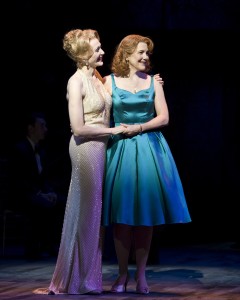 For those not familiar with Follies, here’s what it is in a nutshell: the old theater that once housed the (fictitious) Weismann Follies is about to be razed, and Dmitri Weismann has invited the former Weismann showgirls to meet again before saying goodbye to the theater, and each other, for the last time. They all show up, and we are treated to abbreviated versions of every musical style that ever graced a Follies revue. At the center are two couples: Sally Durant Plummer (Victoria Clark) and her salesman husband Buddy (Danny Burstein), whose marriage has been, to say the least, an emotional disaster; and Ben (Ron Raines) and Phyllis Stone (Jan Maxwell), who have all the surface graces of a financially successful pair but seem to have lost all real feeling between them. They get to the heart of the matter only after revealing their palpable angst and their secret fears, while events of their youthful dalliances are played out by the ghosts of their younger selves. In Act II, these couples play out their own follies in the elaborate “Loveland” sequence.
For those not familiar with Follies, here’s what it is in a nutshell: the old theater that once housed the (fictitious) Weismann Follies is about to be razed, and Dmitri Weismann has invited the former Weismann showgirls to meet again before saying goodbye to the theater, and each other, for the last time. They all show up, and we are treated to abbreviated versions of every musical style that ever graced a Follies revue. At the center are two couples: Sally Durant Plummer (Victoria Clark) and her salesman husband Buddy (Danny Burstein), whose marriage has been, to say the least, an emotional disaster; and Ben (Ron Raines) and Phyllis Stone (Jan Maxwell), who have all the surface graces of a financially successful pair but seem to have lost all real feeling between them. They get to the heart of the matter only after revealing their palpable angst and their secret fears, while events of their youthful dalliances are played out by the ghosts of their younger selves. In Act II, these couples play out their own follies in the elaborate “Loveland” sequence.
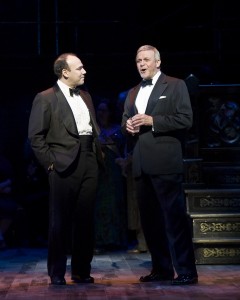 In its current incarnation at the Ahmanson Theater in Los Angeles (with much of the same cast as the 2011 Broadway revival), it begins with the theater shrouded in black crepe while specters of showgirls, in black and grey regalia, roam stealthily through the backstage area’s burnt-out remains. Howling winds are eerily heard in the background. In his attempt at subtlety, director Eric Schaeffer has only made things obvious. “Get ready,” he seems to be saying, “we’re going to finally get Follies right, by making it darker and gloomier than ever.” Oddly, this approach merely emphasizes the sensation that Follies is, at heart, every bit the soap opera that Goldman’s book had always suggested. By the end – when the ghosts are locked into the about-to-be-abandoned old theater – Schaeffer plays into the hands of Goldman’s book, which tends towards the lugubrious and sentimental, and far from the lacerating view of modern life that Sondheim had clearly intended to dissect. Sondheim says that the ghosts of our past cannot be easily locked away; they remain with us forever. It is ironic that Schaeffer, by plunging into the darkness, has merely made it easier to digest the odd contradictions of Follies.
In its current incarnation at the Ahmanson Theater in Los Angeles (with much of the same cast as the 2011 Broadway revival), it begins with the theater shrouded in black crepe while specters of showgirls, in black and grey regalia, roam stealthily through the backstage area’s burnt-out remains. Howling winds are eerily heard in the background. In his attempt at subtlety, director Eric Schaeffer has only made things obvious. “Get ready,” he seems to be saying, “we’re going to finally get Follies right, by making it darker and gloomier than ever.” Oddly, this approach merely emphasizes the sensation that Follies is, at heart, every bit the soap opera that Goldman’s book had always suggested. By the end – when the ghosts are locked into the about-to-be-abandoned old theater – Schaeffer plays into the hands of Goldman’s book, which tends towards the lugubrious and sentimental, and far from the lacerating view of modern life that Sondheim had clearly intended to dissect. Sondheim says that the ghosts of our past cannot be easily locked away; they remain with us forever. It is ironic that Schaeffer, by plunging into the darkness, has merely made it easier to digest the odd contradictions of Follies.
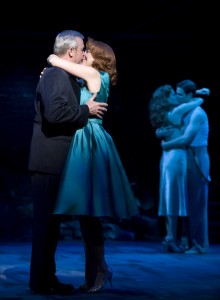 When I saw Follies on Broadway last October, I had some of the same reservations. Like every other revival, it had its moments that outshone similar moments in earlier productions. There was the stunning stillness that Bernadette Peters brought to “Losing My Mind,” wherein Sally releases the madness behind her trembling vulnerability. There was the haunting duet between the operetta star Heidi Schiller and the ghost of her younger self singing “One More Kiss” (a nearly perfect example of a “pastiche” song that evokes the same depth of feeling as any of the Strauss melodies that inspired it) which was exquisitely moving as performed by the elegant Rosalind Elias and Leah Horowitz. And, of course, there was that extraordinary parade of one gorgeous song after another, each so dazzling that one could put up with the arid patches between songs. But on tour, those arid patches – and most of the first part of the evening – now seem lackluster. The decision to replace Ms. Elias with Carol Neblett is an indication of how generally rudderless Schaeffer’s direction is; there is a world of difference between the sculptured brassiness of Ms. Neblett and the genteel fragility of Ms. Elias. The song is still beautifully sung, but the effect is simply not the same.
When I saw Follies on Broadway last October, I had some of the same reservations. Like every other revival, it had its moments that outshone similar moments in earlier productions. There was the stunning stillness that Bernadette Peters brought to “Losing My Mind,” wherein Sally releases the madness behind her trembling vulnerability. There was the haunting duet between the operetta star Heidi Schiller and the ghost of her younger self singing “One More Kiss” (a nearly perfect example of a “pastiche” song that evokes the same depth of feeling as any of the Strauss melodies that inspired it) which was exquisitely moving as performed by the elegant Rosalind Elias and Leah Horowitz. And, of course, there was that extraordinary parade of one gorgeous song after another, each so dazzling that one could put up with the arid patches between songs. But on tour, those arid patches – and most of the first part of the evening – now seem lackluster. The decision to replace Ms. Elias with Carol Neblett is an indication of how generally rudderless Schaeffer’s direction is; there is a world of difference between the sculptured brassiness of Ms. Neblett and the genteel fragility of Ms. Elias. The song is still beautifully sung, but the effect is simply not the same.
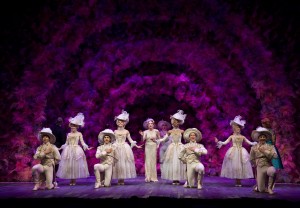 But the real problem with Follies in Los Angeles – and most who see it will not share this experience – was the opening night audience. Their eagerness to adore every moment of the show seemed to act like an aphrodisiac for the actors; and they, in turn, responded by turning each number into an extended orgasm. Elaine Page‘s “I’m Still Here,” Terri White‘s “Who’s That Woman,” and Jayne Houdyshell‘s “Broadway Baby” work best, because these numbers were designed to be show-stoppers. But the dramatic arc of the principals must take them from the songs that establish who they are to the flamboyantly theatrical Loveland sequence, where their nerves are exposed. If Buddy’s “The Right Girl” is as manic as his “The God-Why-Don’t-You-Love-Me Blues,” and if Phyllis’s “Could I Leave You?” is as frantic as her “
But the real problem with Follies in Los Angeles – and most who see it will not share this experience – was the opening night audience. Their eagerness to adore every moment of the show seemed to act like an aphrodisiac for the actors; and they, in turn, responded by turning each number into an extended orgasm. Elaine Page‘s “I’m Still Here,” Terri White‘s “Who’s That Woman,” and Jayne Houdyshell‘s “Broadway Baby” work best, because these numbers were designed to be show-stoppers. But the dramatic arc of the principals must take them from the songs that establish who they are to the flamboyantly theatrical Loveland sequence, where their nerves are exposed. If Buddy’s “The Right Girl” is as manic as his “The God-Why-Don’t-You-Love-Me Blues,” and if Phyllis’s “Could I Leave You?” is as frantic as her “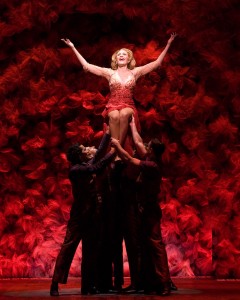 Story of Lucy and Jessie,” then on what journey have they taken us? That is not to say that Danny Burstein and Jan Maxwell aren’t thrilling to watch; it’s just that they seem less intent on kicking us in the groin and more content to kick up their heels. In a Sondheim musical, it is better to be drawn into the heart of a song than to applaud the choreography. Ron Raines does the opposite: Ben’s “The Road You Didn’t Take” possesses the requisite emotional range, but his “Live, Laugh, Love” doesn’t come anywhere near the desperation that finally brings the personal follies of the quartet to a close.
Story of Lucy and Jessie,” then on what journey have they taken us? That is not to say that Danny Burstein and Jan Maxwell aren’t thrilling to watch; it’s just that they seem less intent on kicking us in the groin and more content to kick up their heels. In a Sondheim musical, it is better to be drawn into the heart of a song than to applaud the choreography. Ron Raines does the opposite: Ben’s “The Road You Didn’t Take” possesses the requisite emotional range, but his “Live, Laugh, Love” doesn’t come anywhere near the desperation that finally brings the personal follies of the quartet to a close.
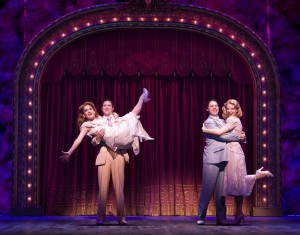 Only Victoria Clark manages to avoid falling into any trap; more suitably cast than Bernadette Peters, she does not erase the memory of Ms. Peters’ splendid creation; instead, she makes nervous but open-hearted Sally her own, and the move from “In Buddy’s Eyes” to “Losing My Mind” is subtly nuanced and dramatically dynamic; and, in a very different way, her “Losing My Mind” is still the high point of this revival.
Only Victoria Clark manages to avoid falling into any trap; more suitably cast than Bernadette Peters, she does not erase the memory of Ms. Peters’ splendid creation; instead, she makes nervous but open-hearted Sally her own, and the move from “In Buddy’s Eyes” to “Losing My Mind” is subtly nuanced and dramatically dynamic; and, in a very different way, her “Losing My Mind” is still the high point of this revival.
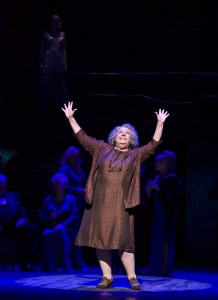 Follies will remain a fabulous musical, and I welcome any revival; but it has dawned on me, with the passing years, that a “definitive” version is highly unlikely if someone doesn’t take a good, hard look at Goldman’s book. But, then again, does any librettist exist who has a lyrical intelligence that matches Sondheim’s?
Follies will remain a fabulous musical, and I welcome any revival; but it has dawned on me, with the passing years, that a “definitive” version is highly unlikely if someone doesn’t take a good, hard look at Goldman’s book. But, then again, does any librettist exist who has a lyrical intelligence that matches Sondheim’s?
Follies
now playing in Los Angeles at the Ahmanson
through June 9, 2012
for tickets, visit http://www.centertheatregroup.org/
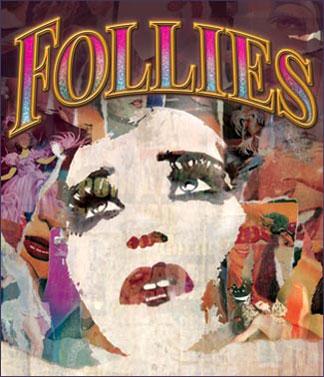

{ 2 comments… read them below or add one }
I saw “Follies” twice on Broadway last Christmas, and had I known how lousy “Relatively Speaking” was going to be (the three one acts including work by Elaine May and Woody Allen), would have seen “Follies” a third time. I agree that Victoria Clark is a better choice for Sally than Peters, who is not a lyric soprano and can’t hit the high notes necessary to sing In Buddy’s Eyes or Losing My Mind. Still, this Follies was remarkable, and quite the best thing I think I’ve ever seen on Broadway, because Follies is such an amazing work. I love the way Barbara Cook sings Sally on the concert CD. I don’t think anyone, not even Dorothy Collins does it as well. Cook breaks your heart as Sally.
Thank you for allowing me to comment! I wish it would tour to Minneapolis.
I’d love to see Danny Burstein and Jan Maxwell again!
I don’t find much value in a review that is supposedly about a current incarnation of a particular show but instead spends most of its length discussing previous versions of the show. I actually had to read through the review a second time to pick out the few places where Mr. Perr tells the reader something about the show that closed last night at the Ahmanson. (And even then he spends much of that precious time shaking his finger at the opening night audience for its excessive enthusiasm, and taking the actors to task for not resisting the tumultuous reception they received. Maybe he shouldn’t have attended opening night?) What I was hoping to find was a thoughtful, reasoned review of the show I saw last night, but unfortunately Mr. Perr chose to give us something more appropriate for Wikipedia.